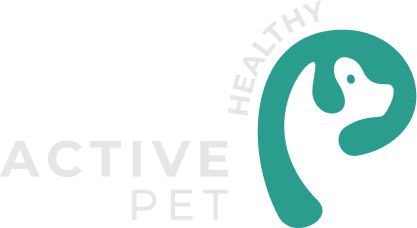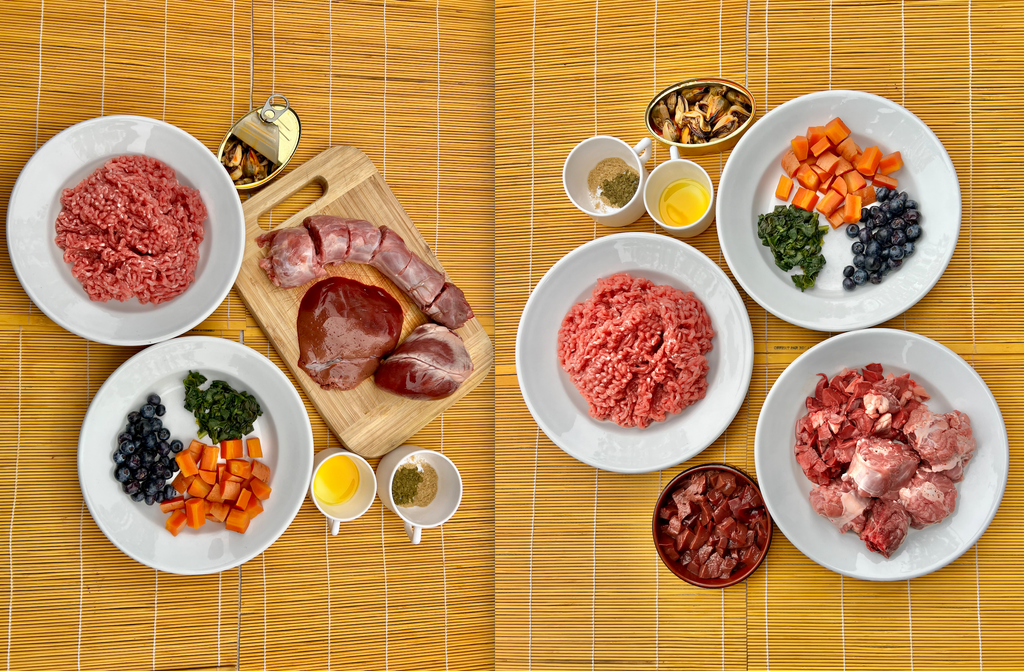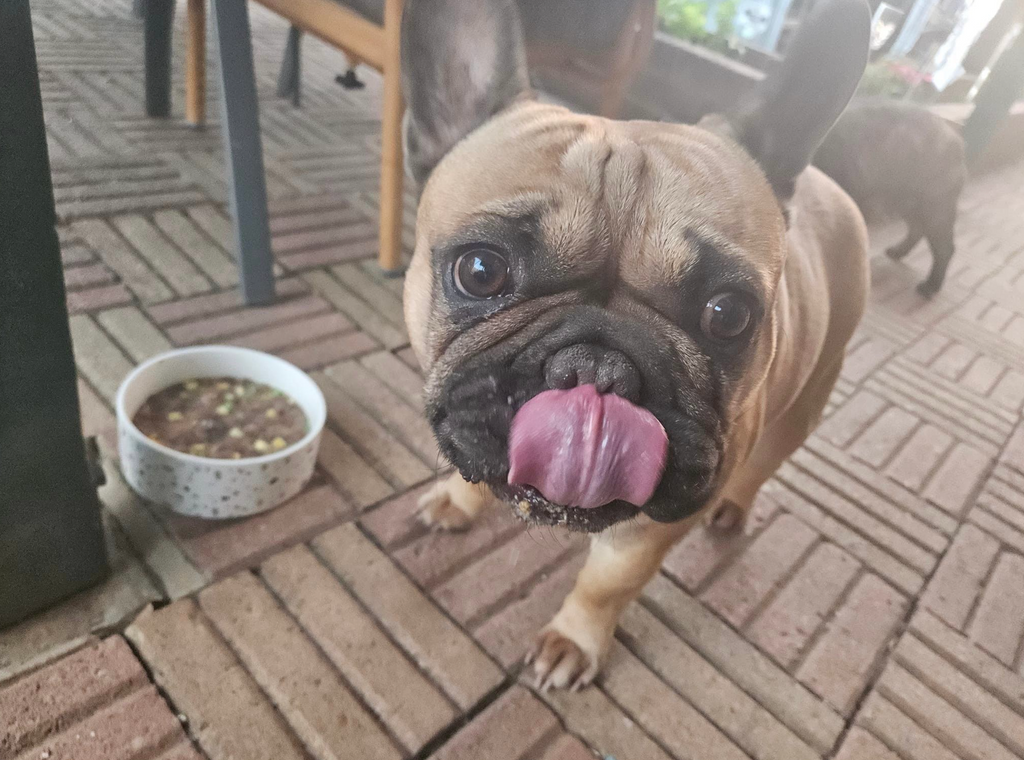
Why Portion Control is Key for Your Dog's Weight Loss Journey
Just like people, dogs can have trouble with their weight. If your dog is overweight, you need to act to help them get to a better weight.
Controlling how much they eat is a big part of this.
Feeding Guide for Overweight Dogs
It's key to figure out the right amount of food for an overweight dog. You need to feed them the amount that helps them lose weight.
How Much to Feed an Obese Dog
Knowing how much to feed an overweight dog can seem hard. But, by creating a feeding plan and adjusting the food amount based on their weight, age, and how active they are, you can do it.
Key Takeaways:
- Controlling how much your dog eats is important for their weight loss.
- You must be careful about the amount of food you give an overweight dog.
- Calculate food amounts by considering their weight, age, and how active they are.
- Having a regular feeding schedule helps with portion control.
- Getting advice from a vet is very important for a weight loss plan for your dog.
Understanding Canine Obesity
Canine obesity is a big problem among our dog friends. Many dogs today are carrying too much weight. It's very important for pet owners to know why this happens and the risks for their pets.

The Causes and Prevalence of Canine Obesity
The main cause of canine obesity is eating more than burning off. This can happen when dogs eat too many calories and don't move enough. Factors include overfeeding, little exercise, and genetic reasons for weight gain.
This leads to many dogs becoming overweight. In Australia, about 56% of dogs are too heavy, risking their health.
The Health Risks Associated with Overweight Dogs
Being overweight can cause many health problems in dogs. This reduces their life quality. Health risks include problems with joints, heart, and breathing. Overweight dogs are also more likely to get diabetes and get sick often.
Canine obesity is a major health issue, not just a visual concern. It needs careful management.
Pet owners can help. They should feed their pets right, control the portions, and make sure they get exercise. It's also good to get advice from professionals when needed.
| Health Risks | Prevalence |
|---|---|
| Joint and mobility issues | 56% of dogs in Australia |
| Cardiovascular problems | |
| Respiratory complications | |
| Risk of diabetes and insulin resistance | |
| Reduced immune system function |
Assessing Your Dog's Weight
Checking your dog's weight is key for their health. It helps you see if they are too heavy or just right. You can tell by looking at their body and comparing it to what's healthy for their breed.
"Regularly assessing your dog's weight helps identify potential weight issues and allows for timely intervention."
Dogs come in all shapes and sizes, so their ideal weight varies. Vets use a body condition score to check if a dog is at a good weight. This score looks at things like if you can see their ribs or if they have a waist.
If your dog is overweight, they could face serious health problems like diabetes or joint pain. That's why it's important to watch their weight. Keeping them at a healthy weight means they will enjoy life more.
Evaluating Body Condition Score
Healthy dogs typically score a 4 or 5 on a 1 to 9 scale. This means they are not too thin or too fat.
Here's what to look for when checking your dog's score:
- Ribs: When you touch your dog's side, you should feel their ribs under a bit of skin.
- Waistline: Looking down on your dog, they should have a clear waist that goes in a bit.
- Abdominal Tuck: A healthy dog has their tummy sloping up slightly, not hanging down.
It's a good idea to keep an eye on your dog's body condition score. If it changes, your vet can help get things back on track.
Consulting Your Veterinarian
Dealing with a dog's weight issues means seeking help from the pros is essential. Your vet is the go-to person for expert advice and a custom weight loss plan for your pet.
Veterinarians have a lot of knowledge about animal health. They can figure out what your dog needs to lose weight safely. They look at things like the dog's breed, age, health, and how it lives to make a plan.
The vet will check your dog's health thoroughly. They will also use things like body scoring to see how much weight your dog should lose. This helps make sure the plan is just right for your dog.
At each step of the weight loss journey, the vet will keep an eye on your dog's progress. They may change the plan as needed. They'll also tell you how much to feed your dog and what kind of exercise is best.
They will also check for any health issues that could be making your dog gain weight. If they find any problems, they can give the right treatment.
Remember, every dog is unique, so a plan that's just for your dog is important. Your vet will guide you, support you, and use their expertise to help your dog reach a healthy weight.
Implementing Portion Control
Portion control is key for overweight dogs. By watching how much they eat, you can help them reach a healthy weight. This also makes them feel better.
Feeding Guide for Obese Dogs
To help obese dogs eat right, follow this guide. It's designed to meet their needs. Below are simple steps to get started:
- Weigh your dog: Knowing your dog's weight is the first step. This tells you how much food they should eat. Ask your vet if you're not sure about your dog's weight.
- Calculate calorie requirements: Your vet will help figure out how many calories your dog needs to lose weight safely. Remember, each dog is different.
- Divide meals: Spread your dog's food over several meals. This stops them from eating too much at once.
- Measuring dog food: Always measure your dog's food. This prevents feeding too much.
- Avoid free-feeding: Letting your dog eat whenever they like can make them gain weight. Set regular mealtimes instead.
- Monitor weight loss: Keep checking your dog's weight and adjust food portions as needed. If anything seems off, talk to your vet.
Portion control is vital for managing your dog's weight. Always work with a vet or pet nutritionist to set the right diet for your dog.
| Benefits of Implementing Portion Control |
|---|
| 1. Weight management: It ensures your dog gets the correct amount of food for staying at a healthy weight. |
| 2. Consistency: A steady feeding schedule gives your dog a reliable routine. |
| 3. Digestive health: The right portion sizes help avoid stomach problems like bloating. |
| 4. Balanced nutrition: It lets you make sure your dog gets all the nutrients they need. |
| 5. Long-term health: Portion control beats obesity and the health problems it brings, like diabetes. |
Choosing the Right Dog Food
Helping your pet lose weight starts with picking the right dog food. It should give them the nutrients they need but help them shed pounds. A great choice is Healthy Active Pet's weight loss freeze-dried dog food.
This special dog food is designed for overweight pets. It uses the best ingredients to create a meal that helps lose weight. But it's still full of energy for your pet.
By freeze-drying this food, all the good stuff stays in. This means your pet gets a nutritious and delicious meal every time. Even the fussiest eaters will love it.
Your pet's meals with this dog food support their weight loss. It has everything they need – proteins, carbs, and more. It keeps them happy and healthy.
"Choosing the right dog food can make a significant difference in your dog's weight loss journey. With Healthy Active Pet's weight loss freeze-dried dog food, you can provide them with the balanced nutrition they need while helping them shed those extra pounds."
Key Benefits of Healthy Active Pet's Weight Loss Freeze-Dried Dog Food:
- Promotes weight loss while ensuring optimal nutrition
- Mixed protein recipe for a balanced diet
- Freeze-dried for maximum nutrient retention
- Highly palatable for even the pickiest eaters
- Thoughtfully formulated to support your dog's weight loss journey
| Nutritional Information | Amount per Serving |
|---|---|
| Protein | 56.2% |
| Fat | 20.3% |
| Fibre | 3.8% |
By choosing Healthy Active Pet's weight loss freeze-dried dog food, you pick an easy and effective way to help your pet lose weight. It's a tasty, healthy option that supports your pet's slimming journey.

The Benefits of Freeze-Dried Dog Food
Selecting the right food for a dog's weight loss is key. Freeze-dried dog food brings many pluses to the table. It ensures dogs get their needed nutrition while slimming down.
One key perk of freeze-dried dog food is keeping nutrients intact. The freeze-drying technique locks in the ingredients' natural value. It ensures your dog gets essential vitamins, minerals, and antioxidants. This is vital for your dog's health during their weight loss phase.
Another plus is how simple freeze-dried food is to manage. You can quickly divide and make meals for your pet. It’s easy and saves time. Plus, these foods are light, perfect for trips or outdoor fun. Your dog’s diet needs are covered, wherever you are.
"Freeze-dried dog food combines the benefits of nutrition retention and convenience, making it an excellent choice for weight loss and overall well-being." - Dr. Jane Adams, veterinarian at Pet Health Clinic.
Also, freeze-dried dog food comes in many tastes and types. This is great for dogs with special diet needs or who prefer certain foods. You can tailor your dog's diet to help them lose weight.
To show how great freeze-dried dog food is, here’s a table that compares it to regular kibble:
| Benefits | Freeze-Dried Dog Food | Traditional Kibble |
|---|---|---|
| Nutrition Retention | Retains essential nutrients through freeze-drying process | May lose some nutrients through processing and storage |
| Convenience | Easy portioning and preparation, lightweight for on-the-go | Requires measuring and preparation, can be bulky for travel |
| Customisation | Wide variety of flavors and formulations to cater to dietary needs | Limited options for specific dietary requirements |
The table clearly shows freeze-dried dog food is superior. It’s better than kibble in preserving nutrients, being easy to handle, and providing choice. Choosing freeze-dried food for your dog's weight loss is a smart move.
The Turkey Freeze-Dried Dog Food Recipe
If your dog is overweight, giving them the right diet is key. Try a freeze-dried turkey dog food recipe. It's low in carbs and full of good nutrition to help your dog get healthier.
Healthy Active Pet's freeze-dried turkey dog food recipe is made to be great for your dog's health and help them lose weight. It has real turkey to make it tasty for dogs.
This recipe is special because it has very few carbs. This is important for a diet that supports weight loss. The low carb mix helps keep your dog's sugar levels steady and their digestion healthy.
Besides turkey, this dog food has fresh fruits and veggies. Wheatgrass, pumpkin, apples, and blueberries are some of the yummy, healthy ingredients. These add important nutrients and antioxidants for your dog's wellness.
These ingredients also make the food more interesting for your pup. Plus, they support a diet focused on losing weight.
The freeze-drying process keeps all the nutrition intact. This means your dog gets all the good stuff in every bite. It's great for helping them reach their weight loss goals by eating nutritiously.

Here's why the turkey freeze-dried dog food recipe is so good:
- Low carbohydrate content for stable blood sugar levels
- Real turkey as the primary protein source
- Fresh fruits and vegetables for essential vitamins and minerals
- Optimal nutrition retention through freeze-drying
| Feature | Details |
|---|---|
| Primary Protein Source | Turkey |
| Carbohydrate Content | Low |
| Fruits & Vegetables | Wheatgrass, Pumpkin, Apples, Blueberries |
| Nutrition Retention | Freeze-drying process |
Adding the freeze-dried turkey recipe to your dog's diet can help a lot. It gives them a balanced meal that is good for weight loss. This supports their health and reaches their weight goals.
Creating a Feeding Schedule
To help overweight dogs, a set feeding schedule is essential. It keeps meal times regular. And it's key for managing their weight and health.
It's vital to stick to feeding times to help overweight dogs. This controls when and how much they eat. It's important for helping them lose weight.
Consider these tips for making a feeding schedule for overweight dogs:
1. Determine the appropriate meal times:
Speak with your vet to pick the best meal times for your dog. Overweight dogs usually do well with two to three small meals daily. This supports better digestion and keeps their metabolism steady.
2. Stick to a consistent schedule:
Setting a regular feeding time is just the start. It's crucial to keep to this schedule every day. Dogs love knowing when they'll be fed. This habit helps them avoid overeating by stopping random snacking.
3. Measure and portion the food:
Getting the right amount of food is key to help your dog lose weight. Your vet can suggest the right portion sizes. By measuring the food, you make sure they get all the needed nutrients and calories.
4. Avoid excessive treats:
Though treats are nice, be careful with them during weight loss. Go for low-calorie options. Check with your vet about how often and what type of treat is okay for your dog.
Setting feeding times and watching food amounts is crucial for your dog's weight. Stick to a plan and help your dog be healthier.
Making a feeding plan for overweight dogs does a lot. It keeps them on a healthy routine. Stick to it, measure their food right, and watch the treats to help them lose weight.
Monitoring Your Dog's Progress
It's important to track your dog's weight loss journey. Overweight dogs need regular weigh-ins. This lets you see if the weight loss plan is working. It also helps you adjust as needed.
Weigh your dog often to get an accurate picture. You can do this at the vet or use a pet scale at home. Make sure to weigh them at the same time every week for the best results.
Record your dog's weight each time. Use a journal or a weight tracking app. This data helps you spot trends. It also shows if there are times when they aren't losing weight. Then, you can tweak their diet and exercise.
Watching for body changes is key too. Signs like a slimmer waist or less fat around the ribs and hips mean they're getting healthier. You'll also see they have more energy and move better as they lose weight.
Changes in their eating, drinking, or toilet habits can tell you a lot. These clues hint at their general health. If you detect anything odd, get your vet's advice.
"Weigh your dog often and watch their body shape. This is vital for their weight loss. It helps you adjust their routine, keeping them healthy." - Dr. Emily Thompson, Veterinary Specialist
By keeping track of your dog's weight loss, you're helping them stay healthy and happy. Always reach out to your vet for guidance during this process.
| Benefits of Monitoring Your Dog's Progress |
|---|
| Regular weigh-ins help track your dog's weight loss accurately |
| Observing changes in body condition ensures the effectiveness of their weight loss plan |
| Allows timely adjustments to diet and exercise routine |
| Indicates improvements in overall health, energy levels, and mobility |
| Provides insights into any potential health concerns |
Exercise and Other Lifestyle Factors
Regular exercise is key in helping overweight dogs lose weight. It helps them use up extra calories and gets them in better shape. It also boosts their mental health.
Dogs need to move to stay a healthy size and avoid obesity issues. So, exercising your overweight dog supports their weight loss and makes their life better.
The exercise plan for your dog will vary based on their health and physical shape. It's wise to chat with your vet first. They can suggest the best activities and help you make a plan.
“Physical activity should be enjoyable for both you and your dog. Find activities that you both enjoy and can do together," says Dr. Emma Thompson, from Healthy Active Pets Clinic. “This will make it easier to stick to the exercise routine and ensure consistent participation."
Regular exercise not only helps dogs burn excess calories, but also improves their overall fitness and mental well-being.
Besides exercise, changing your lifestyle can help your dog lose weight. Here are some tips:
- Give them interactive toys to keep them sharp and happy, stopping overeating.
- Watch the treats. Cutting back can stop your dog from eating too many calories.
- Up the play and training time to keep them moving.
- Stick to a feeding schedule. It helps control portions and keeps meals steady.
- Feed them a diet made for losing weight. Foods like Healthy Active Pet's freeze-dried turkey can control calories.
By adding these changes to your dog's life and keeping up with exercise, you can really help them lose weight. It takes time, so stay patient. By focusing on their activity and making healthy life changes, your dog can reach a better weight.
Conclusion
To help an obese dog lose weight, you need to take a complete approach. This includes controlling the amount they eat and making sure their diet suits them. We talked about how watching food amounts is crucial. This step is vital for helping your dog lose extra weight and stay at a healthy weight.
It's very important to talk to a vet before you start. They will check your dog's weight and make a plan just for them. A vet will give you expert advice and keep an eye on how your dog is doing. Also, the right food, like Healthy Active Pet's weight loss freeze-dried dog food, can help your dog get the nutrition they need while losing weight.
Stick to your plan every day. Set a regular time to feed your dog, keep checking their weight, and include lots of play and walks. Changing some parts of your life might also be needed. All these steps, together, are the best way to help your dog lose weight. After all, your pet's health is what matters most.
FAQ
Why is portion control important for managing an overweight dog's weight loss journey?
Portion control is key for an overweight dog's journey to lose weight. It helps manage their calories and nutrients rightly. This method slowly reduces their weight, making them healthier.
What are the potential health risks of having an overweight dog?
An overweight dog may face many health problems. They include diabetes, heart issues, and joint pains. Taking action early can prevent these and help your dog live longer and better.
How can I assess if my dog is overweight?
To check if your dog is overweight, look at their body shape and feel for excess fat. Also, compare their condition to the ideal weight for their size. A vet can offer more help in checking your dog's weight.
Why is it important to consult a veterinarian for weight loss guidance?
Getting professional advice from a vet is vital for your dog's weight loss. They can create a special plan for your dog. This plan will include the right food, exercise routines, and check-ups.
How do I implement portion control for my overweight dog?
To control portions, follow a feeding guide suited to your dog's needs. Use a kitchen scale or a measuring cup to ensure correct food amounts. This is crucial for their weight loss.
What should I consider when choosing the right dog food for weight loss?
For weight loss, choose dog food that's balanced and made for managing weight. Healthy Active Pet's weight loss freeze-dried food is a good option. It offers a varied protein mix and the nutrients your dog needs.
What are the benefits of freeze-dried dog food for weight loss?
Freeze-dried dog food is great for losing weight. It retains nutrients and flavours well. Plus, it's easy to store and use. It can be part of a healthy diet that supports your dog's weight loss.
Can you provide more information about the turkey freeze-dried dog food recipe for weight loss?
The turkey freeze-dried food is low in carbs and great for dog weight loss. It includes turkey, fruits, vegetables, seeds, and superfoods for a balanced diet. This recipe helps with weight loss while meeting your dog's nutritional needs.
How can I create a feeding schedule for my overweight dog?
For an overweight dog, set up regular meal times with the right portion sizes. Serve their food in smaller meals over the day. This keeps their eating consistent and helps in their weight management.
Why is it important to monitor my dog's progress during their weight loss journey?
Checking your dog's weight loss regularly is important to see how they're doing. It helps you know if the plan is working and make any needed changes. It's about ensuring they are getting healthier.
What role does exercise play in managing weight loss for dogs?
Exercise is essential for your dog to lose weight. It burns calories and improves fitness. Activities like walks and play are fun but also help in losing weight and staying healthy.
What lifestyle changes can support my dog's weight loss?
Alongside diet and exercise, make other changes to help your dog. Cut down on treats and scraps. Keep them mentally stimulated with toys. A calm environment is also important. These steps aid in keeping their weight balanced.



